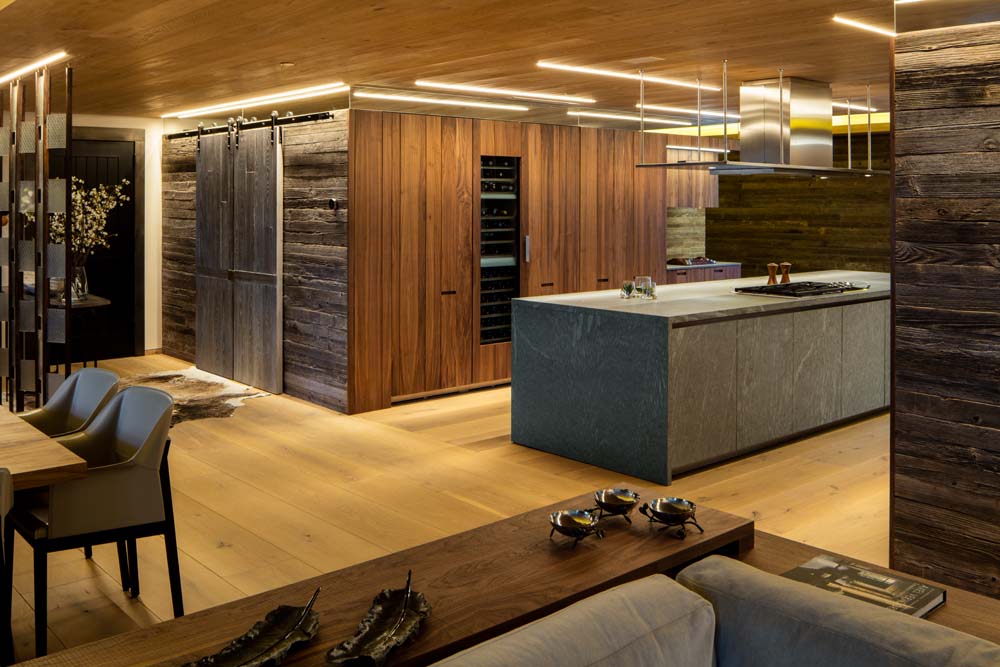HOW DO DESIGNERS TRANSCEND GEOGRAPHY FOR TRANSATLANTIC CUSTOMIZATION? FOR LUXURY ITALIAN KITCHEN BRAND BOFFI, BLENDING A WORLD-CLASS KITCHEN SEAMLESSLY INTO A COLORADO MOUNTAIN HOME REQUIRED A TEAM OF INTERNATIONAL EXPERTS.

Vail has long bene the beneficiary of natural opulence: resorts, cultural enclaves, and year-round attractions have created an international pull to the mountain community. It’s no wonder, then, that it’d be home to a globe-spanning kitchen project, traversing from Mexico to Miami and across to Italy before calling Colorado home.
WORDS: Cory Phare • IMAGES: James Florio & Kyler Deutmeyer

Precisely 5,317 miles separate the slopes of blue sky basin from Lentate, Italy, the home of international luxury brand Boffi. At first, the difference is striking—the runways of Milan (just south of the company’s home base) couldn’t be further from the Rocky Mountains’ rugged terrain. But a deeper look brings their similarities to light. Beauty. Simplicity. Powerfully mellifluous, defined by purity and linearity.

It is this contoured connection that led to the truly collaborative process of turning a private residence at the Four Seasons Resort Vail into a modern masterpiece. The Mexico-based clients sought to create a space well suited for entertaining, and effortlessly blend both Boffi’s Italian elegance with the discreet rustic feel familiar to mountain environs.
According to designer Simon Hamui, the guiding principle was to create a loft-like open space, simultaneously evincing airy relaxation with stylish sophistication. The key was integrating “… modern design style and understanding the mountain life and surroundings; a good exploration of materials and textures in a natural state is vital,” said Hamui. “To integrate the contemporary design language with the easy, relaxed, informal and organic lifestyle of the mountains is key.”

Framed within Boffi’s Xila line (designed by Luigi Massoni), the central cross-point of the open flow between living space and kitchen is undoubtedly the unique signatory island. Designers landed upon Pietra Del Cardoso, a highly-compressed Italian sandstone which is honed—not polished—for the island’s top, sides, and cabinets. Introduced in the Solferino showroom at Italy’s Salone (and not far from its source), it is a subtle exclamation that, according to Miami-based Boffi Sales Manager Valeria Torriani, was a central component for this groundbreaking project. “This was the first Boffi kitchen made in stone for retail use. The use of stone was mandatory, particularly Cardoso, which has natural veins on a beautiful light grey base.”
The central component serves as both anchor and guide for movement throughout the space, but was not without its challenges. Island cabinet doors are comprised of 6-millimeter stone on a 16-millimeter melamine supporting panel—which through beautiful fronts, created a weight-bearing issue for traditionally hinged doors. The resulting decision was an all-drawer interface, a central component of the Xila configuration. Opened by handrail, the resulting flushed lines complement the monolithic impact created by the solid honed surface.

Warmer wooden textures continue to meld mountain and Milanese, as evidenced by the wall units. Done in solid Calnetto walnut, alternating slats of varying thickness create a three-dimensional “sawn effect.” They are finished with natural vegetable oil-based waxes, and have handles smoothly integrated into the cabinets. Within and beyond, the space also features a white-oiled wide plank natural oak floor, a natural unfinished oak ceiling, and reclaimed thin wood stripes for the corridor wall. “As an open design, [connected to] the living room and also serving as a passageway from public to the more private areas, the kitchen had to seamlessly mend to the rest of the interior,” said Hamui. “Having solid wood, raw finishes, and fully integrated appliances, it did just that.”
But how does one deliver this complementary blend of kitchen components across continents? It turns out the project’s workflow mirrored the seamless convergence of styles found throughout the finished product, and, according to Torriani, was well-worth the time it took to deliver. Starting with space specifications, the team examined what could be transformed, working around existing appliances. Next, a full interior design proposal was constructed with local architect David Sorensen, and once done, presented to the client.

The kitchen was produced in Italy, shipped to Miami, and loaded onto a truck destined for Colorado. Once on site, specialized local teams were enlisted to put together the casework and furnishings. “With today’s tools … it is actually very fluid and takes advantage of the worldwide design community,” said Hamui. And though they faced some challenges with codes and permits, “working with local architects and contractors helped us overcome these obstacles. But not without arduous work and creativity.”

It is this coordinated craft and creativity that resulted in a truly world-class kitchen, blending Italian elegance with a natural Coloradoan context. The result is an exquisite space for entertaining that flows and functions as smoothly as first tracks. And as for the ultimate arbiter of success? “The clients have told me the whole place lives very comfortably, and interacts well socially,” said Hamui. “They find it soothing and relaxing to come home to.”
No individual component may be an island unto itself, but together, each piece contributes to the whole.




